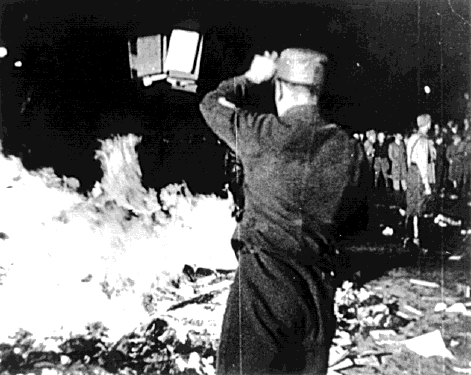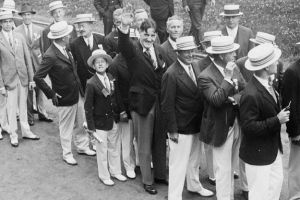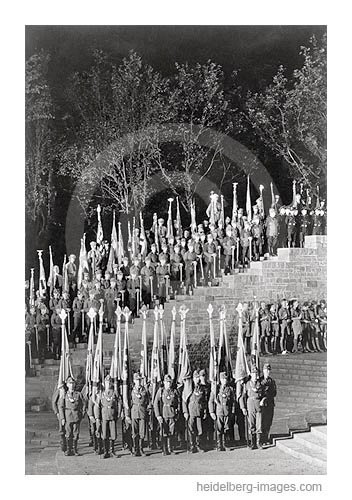by Rebecca Bynum (November 2009)
The Third Reich in the Ivory Tower: Complicity and Conflict on American Campuses
by Stephen H. Norwood
Cambridge University Press, 2009
The academic attitude of high-minded impartiality which seems to hover weightlessly above the crass corpus of power politics, does, in plain fact, aid and abet those who actively seek the destruction of Western civilization. There are times when a principled stand must be taken, for, for all its claims of impartiality, silence implies acquiescence. This was as true during the 1930’s as it is today, when apologists for the Islamic brand of fascism are routinely given respectful hearings in lecture halls and platforms in student newspapers at our finest institutions of higher learning. One difference being, in the 1930’s regular newspapers around the country were much more willing to print the brutal facts about the rise of fascism in Europe – facts submitted by clear-eyed on-the-ground reporters such as William L. Shirer, whereas today, the entire press corps seems unreasonably squeamish about publishing the facts on the ground about what occurs in Muslim countries. Of the draconian punishments enforcing conformity in thought, word, dress and deed, public mutilation, public executions, the canonization of suicide bombers, the demonization of Jews, the distortion of history, the conspiracy theories, the economic and intellectual stagnation weighing down the Muslim world – little, if anything, disturbs our nightly news programs.
Yet, today’s papers are so dutiful in publishing the Muslim propaganda angle whenever there is yet another terror-related arrest in the West, they are commonly lampooned with fake headlines such as “Muslims Fear Backlash from Next Tuesday’s Terror Attack” on the internet. The academic eagerness to side with any movement that denigrates the Western world has become even more of a joke and it would be funny if it weren’t so dangerous. Fascism is fascism whether is wears of robes of religion or not.
In The Third Reich in the Ivory Tower, Professor Norwood lays out in a calm, unemotional and scholarly manner the full extent to which our most prestigious institutions of higher learning purposefully lent legitimacy and gave succor to both Nazi Germany and fascist Italy and how they refused to aid their victims, Jewish refugee scholars and students, by pretending that scholarly pursuits must remain “above” politics.
It is little remembered now, just how deep and broad antisemitism ran in pre-World War II America. The elite schools all had policies in place (either officially as at Harvard or unofficially as at the elite girls’ schools) to keep Jewish enrollment to a minimum. A poll taken by the Student Opinion Survey of America in December, 1938 (after Kristallnacht), revealed an overwhelming majority (68.8%) of students believed that “Jewish refugees should not be admitted into the United States in great numbers.”
 This was not antisemitism on violent display as in Nazi Germany; it lay beneath the surface, unspoken, but it allowed the leaders of these elite institutions to downplay the anti-Jewish policies and atrocities that were clearly occurring in Nazi Germany throughout the 1930’s. These prestigious Universities ignored the purging of Jewish professors, the segregation of Jewish students, the burning of Jewish books and the Nazification of education in general and continued to act as if nothing untoward were happening in Germany that should interfere with normal scholarly relations.
This was not antisemitism on violent display as in Nazi Germany; it lay beneath the surface, unspoken, but it allowed the leaders of these elite institutions to downplay the anti-Jewish policies and atrocities that were clearly occurring in Nazi Germany throughout the 1930’s. These prestigious Universities ignored the purging of Jewish professors, the segregation of Jewish students, the burning of Jewish books and the Nazification of education in general and continued to act as if nothing untoward were happening in Germany that should interfere with normal scholarly relations.
These schools continued to engage in student exchange programs with German Universities even though the students chosen to come to America were invariably thorough young Nazis and were openly viewed as propaganda vehicles by the German government. Those Americans who went to Germany roomed with Nazis, went to Nazified universities and heard and saw nothing to contradict the wonderful view of the Third Reich that they then dutifully reported to student newspapers upon their return. These same American Universities invariably welcomed the Nazi ambassador the U.S., Hans Luther, with deference and Nazi propagandists such as Ernst “Putzi” Hanfstaengl with respect, frowning on any ruckus made by protesters or overly diligent reporters.

Ernst “Putzi” Hanfstaengl, center arm raised
Illustrating this attitude well is a speech given by Dean Virginia C. Gildersleeve of Barnard College in April 1933. She “labeled the situation in the Third Reich ‘disconcerting’ but urged her audience not to judge Germany by American standards. The outlook and behavior of an ‘alien’ people might appear eccentric but if Americans knew ‘the circumstances in which seemingly unreasonable actions take place, those actions would seem reasonable.’ Gildersleeve concluded: ‘Perhaps if we knew more of the facts we could understand what the German people are feeling and trying and wanting to do.’”
Of course, the trouble with the Nazi movement was our own lack of tolerance and understanding toward it: we should simply have acquiesced to Germany’s “legitimate aspirations.” Even more ridiculous, but every bit as reminiscent of our own time, was a speech given by University of Berlin Professor Friedrich Schoenemann at Vassar entitled, “The New Democracy in Hitler’s Germany.” In it, “Professor Schoenemann compared the Nazi takeover in Germany with the American Revolution and explained that ‘at bottom [Hitler] is a democrat.’ Schoenemann claimed that reports of Nazi atrocities against Jews were false, ‘invented purely for propaganda purposes.’ He claimed that Jews led the Communist movement and at the same time dominated ‘all the money-making professions in Berlin.’ Schoenemann denounced Albert Einstein for not ‘suspend[ing] his judgment’ about the Hitler government ‘until he knew the facts.’”
Professor Schoenemann had been shouted down “with laughter, hisses and shouts of liar” by the average people of Boston when he spoke at the Ford Hall Forum on Beacon Hill. Anti-Nazi protests against him were so vehement that it turned Beacon Hill into a battle zone. Mounted police finally drove the protesters, estimated at between 3,000 and 5,000, many carrying banners which read, “Down with the Nazi Butcher” and “Down with Hitler” down “the steep slopes of Beacon Hill, chasing them a half-mile through the streets and ‘smashing heads right and left.’ The demonstrators ‘fighting every inch of the way,’ pulled some policemen off their horses and pummeled them. Police reinforcements finally ‘lifted the siege of Beacon Hill.’” However, at Vassar, Schoenemann received a quiet and respectful hearing by the impressionable young women and their professors.
The University of Virginia, Institute of Public Affairs periodically held roundtable conferences in which they seemed to go out of their way to provide a forum for the German antisemitic point of view, hosting American antisemites like William J. Cameron as well as German propagandists like Friedrich E. Auhagen, who was arrested as a Nazi agent and deported after the war. At the 1939 conference held less than two months before the German invasion of Poland, Manfred Zapp, New York representative of the Transocean News Service of Berlin, “delivered a vitriolic anti-Semitic address in which he proclaimed his ardent support for Nazi Germany. He began by condemning the ‘one-sided’ American press coverage of Germany, which falsely reported that in the Third Reich ‘the individual has no freedom.’ Germans actually had ‘just as much freedom as…in other countries, if not more.’ Unlike in the West, where the rich could buy more liberties than were granted the poor,’ each individual in Germany had an equal amount. The Germans had forged a national community, a true ‘people’s state,’ unlike parliamentary democracies which were actually ruled by ‘demagogue politicians.’ Under the Weimar Republic, Germans were divided by class antagonisms and feared for their safety. Night clubs featuring ‘nudism and sex’ proliferated, undermining the country’s moral fabric.
“Zapp declared that during the Weimar period a corrosive ‘Jewish influence…became more and more predominant in business and politics.’ By ‘preaching freedom of the press, freedom of speech, and freedom of the individual’ the Jews ‘sowed discontent among the German people,’ fomenting divisions that resulted in twenty-eight different political parties bickering in the Reichstag. Exploiting the chaos they had fomented, the Jews seized control of the nation.
 “According to Zapp, the Nazi movement arose to liberate Germany from the Jewish-induced decay. It sprang from ‘German sentiment,’ grew ‘on German soil,’ and was ‘made for Germans and Germany only.’ Hitler had restored labor harmony and full employment. Under Nazism, prosperity had returned to Germany, and slums had disappeared.”
“According to Zapp, the Nazi movement arose to liberate Germany from the Jewish-induced decay. It sprang from ‘German sentiment,’ grew ‘on German soil,’ and was ‘made for Germans and Germany only.’ Hitler had restored labor harmony and full employment. Under Nazism, prosperity had returned to Germany, and slums had disappeared.”
Of the American student newspapers, only the Columbia Spectator mounted any serious opposition to the school administrations’ policies. Both the Harvard Crimson and the Yale Daily News towed the official line of fascist sympathy. Columbia’s President, Nicholas Murray Butler (winner of the Nobel Peace Prize in 1931), took the extraordinary step of expelling a student for organizing a protest against Columbia for sending a delegate to the Nazified University of Heidelberg for its 550th anniversary. Goebbels used the occasion to stage the usual brownshirted propaganda pageant.
 Another interesting aspect about President Butler’s character was his inordinate fondness for Benito Mussolini. Columbia’s Casa Italiana became a veritable hot house of black-shirted fascists. In 1931, Butler, in his welcoming address to incoming freshmen declared, “the assumption of power by a virtual dictator whose authority rests on a powerful and well-organized body of opinion” creates leaders “of far greater intelligence, far stronger character and far more courage than does the system of election.” Butler and Mussolini maintained a warm and cordial personal relationship over many years and the emissaries of El Duce were welcomed at Columbia throughout the thirties. Nicholas Butler was so well known and respected in America that the New York Times printed his Christmas greeting to the nation each December.
Another interesting aspect about President Butler’s character was his inordinate fondness for Benito Mussolini. Columbia’s Casa Italiana became a veritable hot house of black-shirted fascists. In 1931, Butler, in his welcoming address to incoming freshmen declared, “the assumption of power by a virtual dictator whose authority rests on a powerful and well-organized body of opinion” creates leaders “of far greater intelligence, far stronger character and far more courage than does the system of election.” Butler and Mussolini maintained a warm and cordial personal relationship over many years and the emissaries of El Duce were welcomed at Columbia throughout the thirties. Nicholas Butler was so well known and respected in America that the New York Times printed his Christmas greeting to the nation each December.
The nation’s Catholic Universities, following the Vatican’s lead, likewise invariably lent their sympathies to the fascist cause. The Catholic Church viewed communism as the greatest threat to civilization and took up the fascist cause as an aspect of anti-communism, this was especially evident during the Spanish Civil War. Curiously, if there were protests against the Nazi treatment of Jews, the Catholic school organs usually used the term “the mistreatment of Catholics and Jews,” as though the two groups suffered equally.
Another prominent University President in the 1930’s was James Bryant Conant, President of Harvard 1933-1953. He maintained the quota limiting Jewish enrollment begun by his predecessor, Abbott Lowell, allowed Putzi Hanfstaengl to give the commencement address of 1934 and maintained excessively deferential relations with the Nazi ambassador, Hans Luther. Conant continually turned a blind eye to Nazi atrocities and it is clear from the mountain of evidence amassed by Dr. Norwood that he was an antisemite and Nazi sympathizer.
 Though he had turned his back on the Jewish refugee scholars during the 1930’s, during the last year of Conant’s Presidency at Harvard, he hired the former Nazi nuclear physicist, Carl Friedrich von Weizsaecker to teach there. Von Weizsaecker had been deeply involved in the push for the Nazi atomic bomb. After leaving Harvard in 1953, Conant became the American Ambassador to West Germany where he pressed for the early release of imprisoned Nazi war criminals. In 1950, 3,649 of the most hardened Nazis were being held by the Allies. By January 1955, 3,300 had been released. By June of that year the U.S. held only 42 remaining war criminals.
Though he had turned his back on the Jewish refugee scholars during the 1930’s, during the last year of Conant’s Presidency at Harvard, he hired the former Nazi nuclear physicist, Carl Friedrich von Weizsaecker to teach there. Von Weizsaecker had been deeply involved in the push for the Nazi atomic bomb. After leaving Harvard in 1953, Conant became the American Ambassador to West Germany where he pressed for the early release of imprisoned Nazi war criminals. In 1950, 3,649 of the most hardened Nazis were being held by the Allies. By January 1955, 3,300 had been released. By June of that year the U.S. held only 42 remaining war criminals.
Among those Conant advocated for was Josef “Sepp” Dietrich, a man as deeply involved with the Nazi movement as it was possible to be. He had been with Hitler since the earliest days before the Munich Putsch. He was a street brawler and Hitler’s first driver/bodyguard. He acted as head of Hitler’s bodyguard in the early years before Heinrich Himmler took over and it became the elite SS. Hitler placed Dietrich in the Waffen SS and eventually used him to take over a panzer division during the Battle of the Bulge. There, Dietrich massacred American prisoners of war. He was convicted at Nuremberg for his part in the “Night of the Long Knives.”
Dietrich died of natural causes at his home in Ludwigsburg in 1966 at the age of 73. Seven thousand of his wartime comrades came to his funeral. He was eulogized by former SS-Obergruppenführer and General of the Waffen-SS, Wilhelm Bittrich.
Ambassador Conant also approved the release of Konstantin von Neurath, formerly Hitler’s foreign minister and Reich’s protector of Bohemia and Moravia, after he had served only eight years. Von Neurath returned home to a hero’s welcome, complete with strewn flowers and church bells. Conant also helped to parole Joachim Peiper who had engaged in the sadistic burning of Russian villages on the eastern front during the war.
After stepping down as West German Ambassador, Conant gave a series of lectures at Harvard in which he maintained that “persons who had not lived in a totalitarian society had no right to condemn the German people for their behavior when Hitler was in power” and that most of them were never “real” Nazis. Which means as little as the current academic contention that Muslims do not “really” believe in Islam, after all, most academics don’t “really” believe in anything and wouldn’t be caught dead with a firm conviction.
William L. Shirer, on the other hand, declared in a lecture at Boston’s Ford Hall Forum in 1961 that Adenauer’s Foreign Ministry was “shot through and through with Nazis” and that a Nazi past, no matter how horrendous, was no handicap to advancement in West Germany – which, of course, was the simple, honest truth. Something that had evaded the learned men of academia.
Professor Norwood’s book should be assigned in every college in America. It is structured to allow easy comprehension – the beginning of the chapter gives an outline of the material to be presented, the evidence is then then laid out in an orderly, dry fashion, and then a conclusion re-caps and summarizes the evidence, making it easy to understand and to retain.
Though it is not covered in Norwood’s book, there is no doubt that academics in Germany quickly acquiesced to the Nazification of education. In America today there is evidence of acquiescence to the Islamization of education on all levels, from the insertion of Islam into the elementary and secondary textbooks, to the overwhelming support for the suppression of freedom of expression in the Universities.
In the words of one great American, “It’s deja vu all over again,” and fascism is fashionable once more.
To comment on this article, please click here.
If you have enjoyed this article, and would like to read more by Rebecca Bynum, click here.
Rebecca Bynum contributes regularly to The Iconoclast, our Community Blog. Click
- Like
- Digg
- Del
- Tumblr
- VKontakte
- Buffer
- Love This
- Odnoklassniki
- Meneame
- Blogger
- Amazon
- Yahoo Mail
- Gmail
- AOL
- Newsvine
- HackerNews
- Evernote
- MySpace
- Mail.ru
- Viadeo
- Line
- Comments
- Yummly
- SMS
- Viber
- Telegram
- Subscribe
- Skype
- Facebook Messenger
- Kakao
- LiveJournal
- Yammer
- Edgar
- Fintel
- Mix
- Instapaper
- Copy Link









